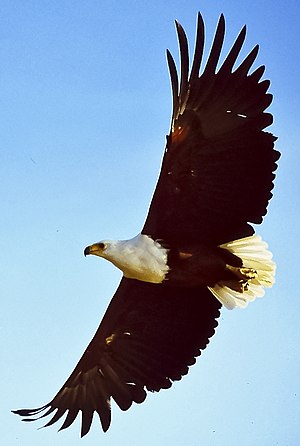African fish eagle: Difference between revisions
No edit summary |
m Add zh |
||
| Line 106: | Line 106: | ||
[[pl:Bielik afrykański]] |
[[pl:Bielik afrykański]] |
||
[[fi:Kiljumerikotka]] |
[[fi:Kiljumerikotka]] |
||
[[zh:吼海雕]] |
|||
Revision as of 17:24, 24 August 2007
| African Fish Eagle | |
|---|---|

| |
| Scientific classification | |
| Kingdom: | |
| Phylum: | |
| Class: | |
| Order: | |
| Family: | |
| Genus: | |
| Species: | H. vocifer
|
| Binomial name | |
| Haliaeetus vocifer | |
The African Fish Eagle (Haliaeetus vocifer[1]) or - to distinguish it from the Ichthyophaga true fish eagles, African Sea Eagle - is a large species of eagle and a bird of prey.
Its closest relative appears to be the critically endangered Madagascar Fish-eagle. As in all sea-eagle species pairs, this one consists of a white-headed species (the African Fish Eagle) and a tan-headed one. These are an ancient lineage of sea-eagles, and as such have dark talons, beaks, and eyes (Wink et al. 1996). Both species have at least partially white tails even as juveniles.
Description


The African Fish Eagle is a large bird, and the female is larger than the males. Males usually have a wingspan of about 2 m (6 feet), while females have wingspans of more than 2.4 m (8 feet). They are very distinctive in appearance with a mostly brown body and large, powerful, black wings. The head, breast, and tail of African Fish Eagles are snow white and the hook-shaped beak is mostly yellow with a black tip.
Range and habitat
This species is still quite common near freshwater lakes, reservoirs, or rivers, although they can sometimes be found near the coast at the mouths of rivers or lagoons. As their name implies, African Fish Eagles are indigenous to Africa, ranging over most of continental Africa south of the southern-most edge of the Sahara Desert.
Reproduction
Breeding season for African Fish Eagles is during the dry season, when water levels are low. African Fish Eagles are believed to mate for life, and pairs will often maintain two or more nests, which they will frequently re-use. Because nests are re-used and built upon over the years the nests can grow to be quite large, some reaching 2m (six feet) across and 1.2 m (4 feet) deep. The nests are placed in a large tree and built mostly of sticks and other pieces of wood.
The female lays 1 to 3 eggs, which are primarily white with a few reddish speckles. Incubation is mostly done by the female, but the male will incubate when the female leaves to hunt. Incubation lasts for 42 to 45 days before the chicks hatch. The eggs will often hatch a few days apart, and the eldest chick will usually kill any younger chicks. Fledging lasts for 70 to 75 days, and after about 8 weeks the chick is capable of feeding itself and will usually begin to venture outside of the nest 2 weeks later.

Diet
The African Fish Eagle feeds mainly on fish, which, upon spying it from a perch in a tree, it will swoop down upon and snatch from the water with its large clawed talons and fly back to its perch to eat. Should the African Fish Eagles catch a fish over 1.8 kg (4 pounds) it will be too heavy to allow it to get lift, so it will instead drag the fish across the surface of the water until it reaches the shore. If it catches a fish that is too heavy to even allow the eagle to sustain flight, it will drop into the water and paddle to the nearest shore with its wings. It will also feed on waterfowl, small turtles, baby crocodiles, and carrion.
References
- Template:IUCN2006 Database entry includes justification for why this species is of least concern
- Wink, M.; Heidrich, P. & Fentzloff, C. (1996): A mtDNA phylogeny of sea eagles (genus Haliaeetus) based on nucleotide sequences of the cytochrome b gene. Biochemical Systematics and Ecology 24: 783-791. doi:10.1016/S0305-1978(96)00049-X PDF fulltext
Footnotes
- ^ Etymology: Haliaeetus, New Latin for "sea-eagle". vocifer, from Latin vox, "voice" + -fer, one who bears something, in allusion to the conspicuous yelping calls. These are, when sitting, given with the head fully thrown to the back, a peculiarity found among sea-eagles only in this and the Madagascar species.
- Least concern species
- Eagles
- Haliaeetus
- Birds of Africa
- Birds of South Africa
- Birds of prey
- Birds of Lesotho
- Birds of Swaziland
- Birds of Botswana
- Birds of Namibia
- Birds of Zambia
- Birds of Zimbabwe
- Birds of Angola
- Birds of Malawi
- Birds of Tanzania
- Birds of the Democratic Republic of the Congo
- Birds of Rwanda
- Birds of Burundi
- Birds of Congo
- Birds of Gabon
- Birds of Equatorial Guinea
- Birds of Uganda
- Birds of Kenya
- Birds of Ethiopia
- Birds of Eritrea
- Birds of Djibouti
- Birds of Sudan
- Birds of the Central African Republic
- Birds of Chad
- Birds of Cameroon
- Birds of Nigeria
- Birds of Niger
- Birds of Togo
- Birds of Benin
- Birds of Burkina Faso
- Birds of Ghana
- Birds of Côte d'Ivoire
- Birds of Liberia
- Birds of Sierra Leone
- Birds of Guinea
- Birds of Guinea-Bissau
- Birds of Gambia
- Birds of Senegal
- Birds of Mali
- Birds of Mauritania